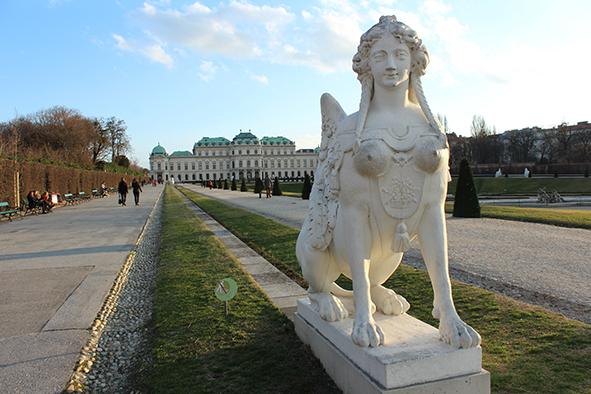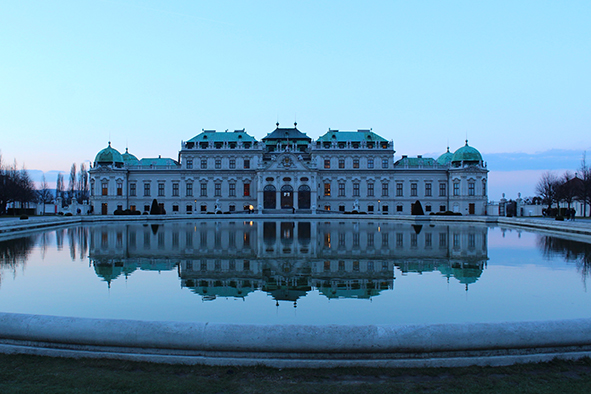For years two stunning Baroque palaces went overlooked. Today, the Belvedere contains hundreds of years of Austrian and European art and is a must-see for any visitor to Austria’s capital city.

A view of the Upper Belvedere from the Gardens (Photo: Tiffanie Wen)
Walking through the Belvedere gardens on a chilly day in February, we have to be sure not to collide with any running Austrians.
The early 18th century complex, located near the center of Vienna, is composed of two magnificent Baroque palaces—the Lower Belvedere and the Upper Belvedere—separated by an impressive terraced garden filled with fountains and statues of Greek gods like Neptune, god of the sea. It’s in the symmetrical rectangular gardens, laid out on a slope, that local Viennese residents jog laps, with their smart phones strapped to their arms.
As I stroll through the gardens with my French-American friend Sarah, she remarks that the gardens remind her of Versailles. It’s not until we leave that we discover why. The manicured walkways and surrounding hedges were designed in jardin à la française, the formal French manner based on symmetry and ordered nature popular in the 17th century, by Parisian landscape designer Dominique Girard, who trained at Versailles under Andre Le Notre.
Today the fountains are empty except for one located on the outer entrance of the Upper Belvedere, but it’s not difficult to imagine water cascading down the 5-tiered fountain at its center.

Statues in the Gardens (Photo: Tiffanie Wen)
Overlooked But Not Forgotten
It is hard to imagine however that the Belvedere, which now houses one of Vienna’s most important collections of Austrian and European art, was ever overlooked or disfavored for other Austrian palaces.
The Belvedere was originally commissioned at the turn of the 18th century by Prince Eugene of Savoy, one of the most successful military commanders in European history who served as a general in the Imperial Army of the Austrian Holy Roman Empire and whose contributions included fighting against the Ottoman Turks in the Battle of Vienna in 1683. Prince Eugene was heavily rewarded for his victories throughout his career and though he never married, became a patron of the arts and amassed a priceless collection of paintings and manuscripts during his lifetime.
Upon his death however, his estate went to his niece, Princess Maria Anna Victoria, who lived in the Belvedere for a few years before selling everything. Maria Theresa, daughter of Charles VI, bought the complex but favored other palaces, and the Belvedere fell into disuse. Luckily, the palace was brought back to its splendor in 1770, when the family hosted a masked ball for 16,000 guests, and its potential again realized. By the end of the 18th century, the Upper Belvedere housed the Imperial Picture Gallery and was open to the public—establishing it as one of the first public museums in the world.
The complex would change hands again but its role as a museum continued and it was ultimately nationalized after World War I.

Upper Belvedere at dusk (Photo: Tiffanie Wen)
Art From the Middle Ages to Today
As Sarah and I peruse the lower and upper palaces filled with pieces by Conrad Laib, Caspar David Friedrich, Franz Xaver, Auguste Renoir, Egon Schiele, Oskar Kokoschka and Vincent Van Gogh, we decide to play a game I once read about in a Bill Bryson book: we must mentally choose our favorite piece, the item we would want to take home with us if we could.
A couple of decades ago, the choice would have been simple for most visitors. Until 2006, the museum was famously home of Gustav Klimt’s Portrait of Adele Bloch-Bauer I, which was acquired by the museum from Nazi Germany, who had stolen it from a Jewish Viennese family during World War II. In 2004, the original heir recovered it after a lengthy legal process that was dramatized in the 2015 film “Woman in Gold.” In the movie, journalist Hubertus Czernin, played by Daniel Brühl remarks that the painting, created by one of Austria’s most celebrated artists, is the “Mona Lisa of Austria.”
Today the Belvedere still houses the largest collection of Klimt’s work, the most important of which depicts two lovers shrouded in oil paint and gold-leaf in “The Kiss.” Painted in 1907 and 1908, the piece represents Klimt’s “Golden Period” and the Viennese Art Nouveau that characterized Europe’s early modern period.
While I’m immediately drawn to “The Kiss,” Sarah has her eyes on the ceilings. She decides that her favorite item is a chandelier from the two-story Marble Hall, which greets visitors on the main floor after they ascend the Grand Staircase. Originally used as an entryway into a room used for conferences, the Marble Hall boasts a ceiling fresco depicting Prince Eugene by Italian painter Carlo Innocenzo Carlone.
Today the Marble Hall exhibits artist Olafur Eliasson’s work “Five orientation lights.” Originally installed in Italy to create cartographic orientation, the installation is comprised of five miniature lighthouses projecting various colors. In the same room that once hosted Leopold Figl as he signed the Austrian State Treaty, re-establishing Austrian independence, Sarah and I walk around the display, examining the lights from different angles and in varying combinations.
But as the bright lights shine and blend, creating unique color spectrums, I can’t help but think that the contemporary tone seems to pale against the timeless golden glow of the Belvedere.